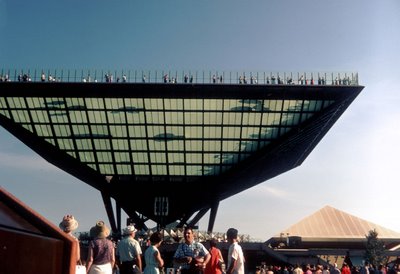The "Katimavik"

The dominant element of the Canadian pavilion, and one of Expo 67's architectual symbols, was the inverted pyramid known as the Katimavik. The origin of this design element is amusing, especially given that we here in Quebec are (finally!) on the eve of a provincial law prohibiting smoking in any public place.
In Yves Jasmin's fabulous book, "La petite histoire d'expo 67", Mr. Jasmin describes the design process of the pavilion which was to symbolize the modern Canada of 1967.
He describes the building of a scale model of this pavilion. The architects working on it were getting ready to go to lunch, when they decided to rest a heavy, inverted-pyramid shaped ashtray on their maquette to hold two glued pieces together during their break.
Upon return from their lunch, they were struck by how elegant this pyramid was, and decided to integrate it into the pavilion's design.
Canada was represented at Expo 67 by, basically... a giant ashtray.
 photo: (top) alamedainfo.com
photo: (top) alamedainfo.com
(bottom) www.space1999.net
In Yves Jasmin's fabulous book, "La petite histoire d'expo 67", Mr. Jasmin describes the design process of the pavilion which was to symbolize the modern Canada of 1967.
He describes the building of a scale model of this pavilion. The architects working on it were getting ready to go to lunch, when they decided to rest a heavy, inverted-pyramid shaped ashtray on their maquette to hold two glued pieces together during their break.
Upon return from their lunch, they were struck by how elegant this pyramid was, and decided to integrate it into the pavilion's design.
Canada was represented at Expo 67 by, basically... a giant ashtray.
 photo: (top) alamedainfo.com
photo: (top) alamedainfo.com(bottom) www.space1999.net
Labels: expo life

1 Comments:
In the da Vinci Code, they talk about the "new" inverted pyramid at the Louvre, in Paris. Who new Montreal was so ahead of its time....
Mom.
Post a Comment